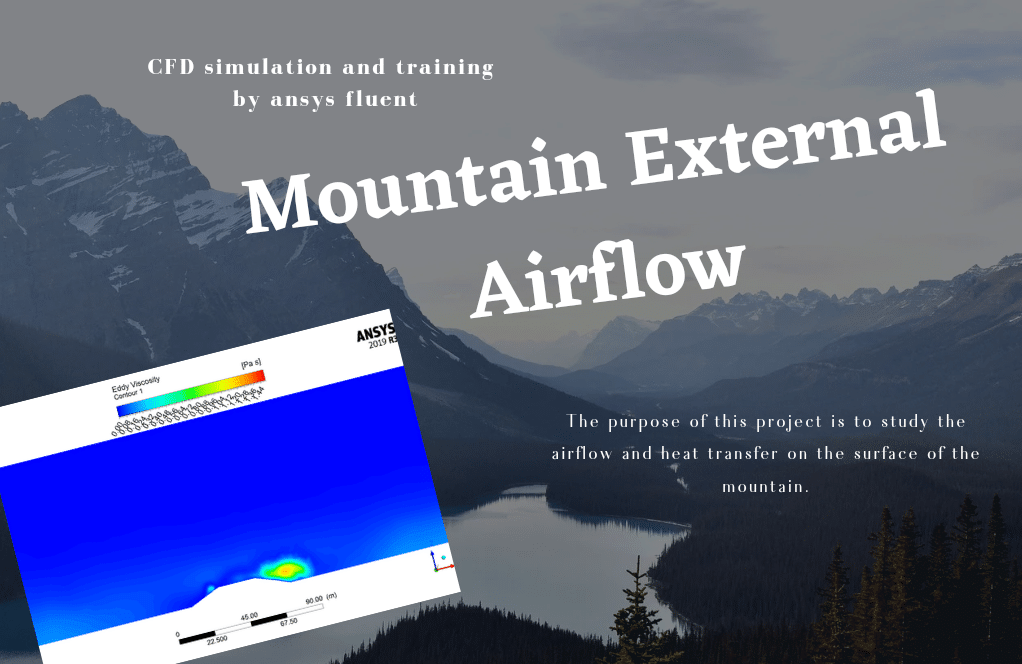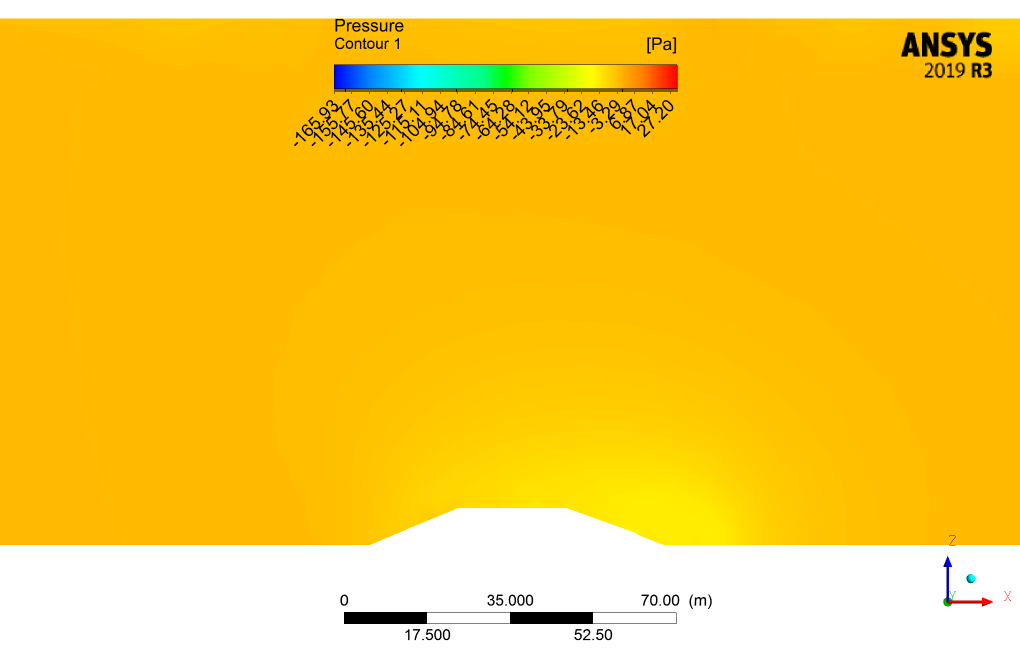Mountain External Airflow Heat Transfer CFD Simulation
Free
- The problem numerically simulates Mountain External Airflow using ANSYS Fluent software.
- We design the 3-D model with the Design Modeler software.
- We Mesh the model with ANSYS Meshing software, and the element number equals 1250044.
- This project is performed in an unsteady state (Transient).
To Order Your Project or benefit from a CFD consultation, contact our experts via email (info@mr-cfd.com), online support tab, or WhatsApp at +44 7443 197273.
There are some Free Products to check our service quality.
If you want the training video in another language instead of English, ask it via info@mr-cfd.com after you buy the product.
Description
Mountain External Airflow CFD Simulation Considering Heat Transfer, ANSYS Fluent Tutorial
The study of natural phenomena has always been of interest to researchers. This project aims to study the airflow and its heat transfer on the surface of the mountain it encounters in the passage, which is also effective in determining the air passage for the aircraft.
The geometry of this model is designed in the ANSYS design modeler and is meshed in ANSYS meshing. The computational domain consists of an airflow inlet, the mountain itself and 3 different pressure outlets (including top and side walls), and the main outlet.
The mesh type used for this geometry is unstructured, and the element number is 1250044.
Methodology
In this project, the air enters the computational domain with a velocity and temperature of 8 m/s and 297.5 K, respectively. The Energy model is activated.
Due to the nature of the external flow type and considering the airflow velocity, which has consequences such as flow separation and vortexes behind the mountain, the K-epsilon Standard model, has been used to analyze the turbulent flow.
Conclusion
The present simulation and its results are Transient. 16-time steps with a step size of 7 seconds are exploited for this simulation. Then, contours of pressure, velocity, temperature, streamlines, and velocity vectors are presented.










Dr. Louie Wolf –
This simulation is a breakthrough in the field of wind pattern analysis over mountainous terrains!
Sammie Shields –
This simulation is a testament to the power of computational fluid dynamics!
Conrad Marquardt –
The time steps in this airflow simulation seem very specific. Can you explain why 7-second intervals were chosen?
MR CFD Support –
The 7-second interval for time steps is chosen based on the characteristics of the flow and the need to capture the dynamic behavior around the mountain accurately. It allows for a balanced compromise between computational cost and the resolution of transient phenomena such as vortex shedding and thermal effects.
Prof. Brenna Bins –
Just finished going through the Mountain External Airflow Heat Transfer CFD Simulation – the level of detail is impressive! This tutorial not only simplifies a complex topic but truly enhances the learning experience. The results after the simulation gave me crystal clear insights into the phenomena of air passage around mountains including pertinent heat transfer effects. The included streamlines and vector visualization nailed it for me.
MR CFD Support –
Thank you for your positive feedback! We are thrilled to hear that our Mountain External Airflow Heat Transfer CFD Simulation tutorial was able to provide you with clear and detailed insights. If you have any more questions or need further assistance in the future, don’t hesitate to reach out. Your success is our goal, and we appreciate you choosing our learning product to expand your knowledge.
Dr. London Yost –
This simulation appears incredible! The level of detail in representing airflow and heat behaviors over mountainous terrain will ideally enhance understanding and applications such as aviation routing. Keep up the fantastic work!
MR CFD Support –
Thank you for the positive feedback on our mountain external airflow heat transfer CFD simulation tutorial! We are thrilled that you recognize the effort put into capturing detailed representations of natural phenomena and its potential applications. Your encouragement is highly appreciated.
Milton Weimann –
Where can I find more information about handling transient simulations for mountain airflow scenarios in ANSYS Fluent? Is there any documentation or user guide that dives deeper into the proper setup for these kinds of simulations?
MR CFD Support –
The best sources for in-depth guidance on conducting transient simulations, especially for mountain airflow scenarios, would be the ANSYS Fluent documentation and user guides. ANSYS offers extensive documentation on their website covering a wide range of topics including transient simulations, setting up complex geometries like mountains, and the specific steps to properly utilize the K-epsilon turbulence model. You might also find tutorial videos, webinars, or community forums helpful where practitioners share their experiences and insights on similar projects.
Eveline Goyette –
Fantastic tutorial! The visualization of aerodynamics around the mountain, along with the heat transfer effects, shed light on key aspects used in environmental and aeronautical studies. The transient analysis provides dynamic insight that steady-state simulations might miss, especially with complex terrain-induced phenomena like flow separation and vortex shedding. Well done on incorporating the k-epsilon standard model for turbulence—essential for accurately capturing the airflow behavior in such scenarios.
MR CFD Support –
Thank you for your positive feedback! We are glad you found the tutorial detailed and helpful. Our goal is always to provide valuable insights and detailed visualization to enhance understanding, especially in complex flow conditions. It’s great to hear that the transient analysis and our treatment of turbulence with the k-epsilon model met your expectations. If you have any more questions or need further assistance, feel free to reach out!
Dr. Will VonRueden –
The visuals from the simulation must be quite captivating. Well done on simulating such a complex natural phenomenon!
MR CFD Support –
Thank you for your kind words! We’re delighted to hear that you appreciate the complexity and the visual aspects of the Mountain External Airflow Heat Transfer CFD Simulation. If you’re considering other natural phenomenon simulations or have any further questions, feel free to reach out. We’re here to help!
Prof. Kamryn Cremin –
Absolutely fascinating results! The visualizations of airflow and heat distribution over the mountain surface enhance the study significantly.
MR CFD Support –
We appreciate your positive feedback! It is great to hear that our simulation could offer valuable insights and that the visualizations helped to understand the phenomena. If there’s anything else you’re curious about, please feel free to reach out. Thank you for choosing our tutorial!
Daphnee Wisozk –
I just finished the Mountain External Airflow Heat Transfer tutorial, and I was blown away by the details on airflow separation! The visuals of the vortex formation were incredibly helpful for understanding the concept.
MR CFD Support –
Thank you so much for your positive feedback! We’re really glad to hear that our Mountain External Airflow Heat Transfer tutorial was both informative and visually helpful for your understanding of complex airflow dynamics. If you have any further inquiries or need more assistance, please feel free to reach out.
Prof. Darrel Bartoletti III –
This tutorial was such a fluid experience; following the steps, I managed to understand airflow heat transfer over the mountain perfectly. I appreciate how well-explained the energy model was and how you described the external airflow environment.
MR CFD Support –
Thank you for your positive feedback! We are thrilled to hear that our tutorial on Mountain External Airflow Heat Transfer helped you understand the concepts clearly and provided an enjoyable learning experience. Should you have any more queries or need further assistance, feel free to reach out!
Prof. Braxton Pouros –
What is the benefit of using CFD for analyzing airflow over mountainous terrains?
MR CFD Support –
CFD allows for detailed analysis of the wind patterns over complex terrains, providing insights that cannot be easily obtained through experiments or field measurements.
Terrance Mitchell –
The ability to customize this simulation for specific terrains and wind conditions is a game-changer!
Pinkie Farrell –
I’m truly impressed with how the Mountain External Airflow Heat Transfer CFD simulation represents the complexities of airflow and temperature distribution. The use of an unstructured mesh to navigate the challenging geometry of a mountain landscape and the transient results truly give depth to understanding environmental aerodynamics at play. Great tutorial for expanding the knowledge base in applied aerodynamics and environmental engineering!
MR CFD Support –
Thank you for your positive feedback! We are delighted to hear that you found the simulation to be well-executed and educational. Understanding airflow and temperature distribution over complex terrains can indeed provide valuable insights, especially in the context of environmental aerodynamics and engineering. We look forward to providing more comprehensive tutorials like this in the future.
Miss Modesta Dare –
The visuals from the simulation look stunning! It’s incredible to see how dynamic airflow and heat distribution are effectively demonstrated across the mountain surface. Superb work on meshing and detailing in this tutorial.
MR CFD Support –
Thank you for your kind words! We’re delighted to hear that the visualizations and detail in the tutorial have significantly added to your understanding of external airflow and heat transfer over mountainous terrain. We strive to deliver informative and visually impactful simulations. If you have any further feedback or need assistance, feel free to reach out.
Maxwell O’Kon –
Was the K-epsilon Standard model chosen for turbulence adequate for capturing the complexity of flow patterns such as flow separation and vortexes around the mountain in this simulation?
MR CFD Support –
Yes, the K-epsilon Standard model is a robust turbulence model suitable for a wide range of flows with moderate levels of turbulence, such as airflow over mountainous terrain. It is generally adequate for capturing complex flow phenomena like separation and vortex formation, especially when the primary interest is in forces like drag and lift rather than highly-accurate turbulent structures.